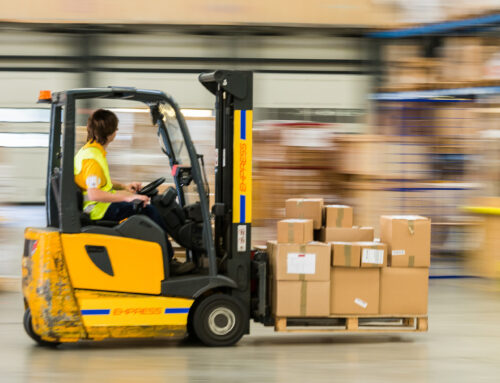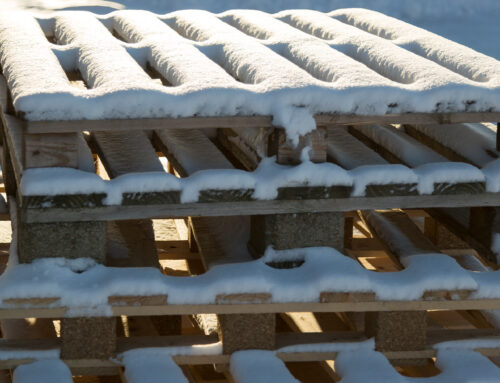For manufacturers, learning how to prevent pallet damage is an important part of their overall supply chain mix. There are a few different reasons why keeping your pallets in good condition is important.
- Damaged pallets can damage the products resting on the pallets.
- Damaged pallets can fail and result in product in-transit damage.
- If you reuse pallets, damaged ones must be taken out of circulation and replaced or repaired.
- Palletized products that face consumers cannot be damaged for both safety and aesthetic reasons.
While it is possible for a pallet to become damaged in a wide variety of ways, the most likely culprit is the forklift. Sometimes it’s just a matter of retraining forklift operators and making them aware of the importance of proper pallet handling techniques, other times it’s just a matter of diligence. Either way, forklift operators can benefit by gaining understanding of what pallet damage costs your company in product damage and pallet replacement.
Here are some specific things that forklift operators should be watching out for to prevent pallet damage:
1. Use the Correct Pallet for the Product and Transportation Conditions
When you look at a palletized product, it’s pretty obvious whether the product fits on the pallet or not, but there are other considerations. Your product might fit on the pallet, but is your pallet properly designed to carry the weight of the product? Products where the weight in not evenly distributed can often cause issues too. Load-bearing capacity over the entire pallet, can make a huge difference, and over-loaded pallets are far more prone to breaking, twisting, or splintering. They’re also more susceptible to damage from improper forklift handling.
2. Keep Warehouse Floor Clutter-Free
Forklift operators need a clutter-free space in which to operate. Minimizing the possible objects that operators can bump into or eliminating the need to maneuver around a lot of things helps limit the risk of pallet damage. Keeping the floor free from debris also helps prevent damage due to bouncing and jostling over junk in the road. That extra bounce a pallet gets when an operator drives over a piece of debris can put a lot of stress on a pallet, as well as increasing the risk of product damage.
3. Stack Pallets Properly
Obviously, pallets are meant to be stacked, but it’s important to make sure that pallets are stacked evenly, centered, and squared up with one another. Proper stacking ensures that weight is distributed properly and prevents damage to the corners and deck boards. Making sure your stacking is centered and squared up also prevents pallet stacks from leaning or falling.
4. To Prevent Pallet Damage, Don’t Rush It
Forklift operators are often in a hurry. Unfortunately, rushing can often be a leading cause of pallet damage. When in a hurry, forklift operators are less likely to pay attention to how pallets are being handled, how their tines are spaced, or whether their tines are all the way under the pallet. A forklift operator in a hurry is also less likely to make sure pallets are stacked up squarely, as well as following basic forklift safety measures.
Taking it a little slower helps prevent the forklift from bumping into the pallet (or product), and ensures that operators pay more attention to tine placement. Taking it easy results in fewer drops or slamming pallets on the ground because operators are paying more attention to their pallet handling. Slowing down helps prevent pallet damage – period.
5. Properly Space Forklift Tines
The majority of pallet damage caused by forklifts is caused by the tines of the forklift. The tines should fit evenly into a pallet without making contact until the pallet is lifted. If tine spacing is off, they can scrape up against pallet stringers and damage them. While there are pallet design features that can help mitigate this problem, proper spacing is still important.
In addition, forklift tines should be spaced as far out as possible. This makes sure that the weight of the pallet is evenly distributed across both tines and helps make moving the load more stable, and helps prevent pallet damage.
6. Fully Clear Pallets
Just as entering a pallet properly helps prevent pallet damage, so does exiting it properly. When forklift operators don’t fully clear the tines from the pallet before turning out, it can cause a tremendous amount of damage to the stringers. Damaging the stringers on a pallet can result in diminished weight capacity and may even cause the pallet to collapse under it’s load. Once a pallet is set down, forklift tines must be fully removed from the pallet before turning out and continuing on to the next task.
7. Avoid Short-Forking
When the tines of a forklift are not fully inserted into the pallet before lifting, it’s called short-forking. Pallets are designed to carry their full load with the tines fully inserted into the pallet, rather than just resting on the tips. Short-forking means that a lot of extra stress is put on the pallet deckboards and fasteners. In turn, this can lead to pallet failure and product damage.
Short-forking can also lead to pallets slipping or falling while they are being moved. When lifting a palletized load, forklift tines should be fully inserted, and the mast of the forklift should be as close to the pallet as possible, to ensure that the load isn’t resting on the tips of the tines.
8. No Pallet Training
Training a pallet means that it’s being pushed across the floor or ground. As you might expect, training pallets can cause a tremendous amount of damage because it puts lateral stress on both the pallet and the fasteners. It can also damage the bottom boards and other component parts of the pallet, which can ultimately lead to pallet failure. Lift pallets properly to prevent pallet damage.
Wrapping It Up
Pallets can become damaged in a variety of ways, but you often need look no further than the forklift to find the most likely source of the damage. While preventing pallet damage may be as simple as re-training forklift drivers and making them aware of the cost of pallet damage to your organization, few would argue the importance of keeping your pallets in good condition.
Replacing damaged pallets is expensive, however, the potential damage to products in-transit can be a real hit to your organization’s bottom line. Learning how to prevent pallet damage, before it happens, is much smarter than trying to mitigate the cost of damages after the fact.






